Online Teaching and Learning of Primary Mathematics in Saudi Arabia: A Study on the Impact of COVID-19
This assignment focuses on the education sector in Saudi Arabia and its development as part of the Saudi Vision 2030 initiative.
116 Pages33613 Words418 Views
Added on 2023-06-10
About This Document
This study examines the impact of COVID-19 on online teaching and learning of primary mathematics in Saudi Arabia. It explores the perceptions of teachers and students, and the effect of gender and years of teaching experience on using online tools. The study aims to contribute to the field of educational research and provide a comprehensive understanding of online learning tools and teaching.
Online Teaching and Learning of Primary Mathematics in Saudi Arabia: A Study on the Impact of COVID-19
This assignment focuses on the education sector in Saudi Arabia and its development as part of the Saudi Vision 2030 initiative.
Added on 2023-06-10
ShareRelated Documents
1.1 Background....................................................................................................................1
1.1.1 Education in Saudi Vision 2030...............................................................................................1
1.1.2 The Educational Impact of COVID-19: The Case of Primary Mathematics Teaching
and Learning in Saudi Arabia..........................................................................................................1
1.1.5 Online Teaching and Learning................................................................................................5
1.3 Significance of The Study...................................................................................................6
1.4 Overview of The Study........................................................................................................7
3.1 Introduction........................................................................................................................3
3.2 Adopted research philosophy..............................................................................................3
3.2.1 Ontology.....................................................................................................................................4
3.2.2 Epistemology.............................................................................................................................5
3.2.3 Pragmatism................................................................................................................................6
3.3 Research design: Mixed methods.......................................................................................7
3.4 Sample sizes and sampling strategies...............................................................................10
3.4.1 Sample sizes.............................................................................................................................10
3.4.1.1 Quantitative stage..............................................................................................................................10
3.4.1.2 Qualitative stage................................................................................................................................12
3.4.2 Sampling strategies.................................................................................................................13
3.4.2.1 Quantitative stage..............................................................................................................................14
3.4.2.2 Qualitative stage................................................................................................................................15
3.5.1 Questionnaire .........................................................................................................................16
3.5.2 Semi-structure interview .......................................................................................................19
3.5.3 Non-participant observation..................................................................................................21
3.6 Pilot study..........................................................................................................................23
3.7 Data analysis.....................................................................................................................23
3.7.1 Quantitative data analysis......................................................................................................23
3.7.2 Qualitative data analysis .......................................................................................................24
3.8 Validity and reliability.......................................................................................................26
3.8.1 Validity ....................................................................................................................................26
3.8.2 Reliability.................................................................................................................................28
3.9 Ethical considerations......................................................................................................29
3.10 Summary.........................................................................................................................31
References...............................................................................................................................32
Introduction chapter: about 2000 words
1.1.1 Education in Saudi Vision 2030...............................................................................................1
1.1.2 The Educational Impact of COVID-19: The Case of Primary Mathematics Teaching
and Learning in Saudi Arabia..........................................................................................................1
1.1.5 Online Teaching and Learning................................................................................................5
1.3 Significance of The Study...................................................................................................6
1.4 Overview of The Study........................................................................................................7
3.1 Introduction........................................................................................................................3
3.2 Adopted research philosophy..............................................................................................3
3.2.1 Ontology.....................................................................................................................................4
3.2.2 Epistemology.............................................................................................................................5
3.2.3 Pragmatism................................................................................................................................6
3.3 Research design: Mixed methods.......................................................................................7
3.4 Sample sizes and sampling strategies...............................................................................10
3.4.1 Sample sizes.............................................................................................................................10
3.4.1.1 Quantitative stage..............................................................................................................................10
3.4.1.2 Qualitative stage................................................................................................................................12
3.4.2 Sampling strategies.................................................................................................................13
3.4.2.1 Quantitative stage..............................................................................................................................14
3.4.2.2 Qualitative stage................................................................................................................................15
3.5.1 Questionnaire .........................................................................................................................16
3.5.2 Semi-structure interview .......................................................................................................19
3.5.3 Non-participant observation..................................................................................................21
3.6 Pilot study..........................................................................................................................23
3.7 Data analysis.....................................................................................................................23
3.7.1 Quantitative data analysis......................................................................................................23
3.7.2 Qualitative data analysis .......................................................................................................24
3.8 Validity and reliability.......................................................................................................26
3.8.1 Validity ....................................................................................................................................26
3.8.2 Reliability.................................................................................................................................28
3.9 Ethical considerations......................................................................................................29
3.10 Summary.........................................................................................................................31
References...............................................................................................................................32
Introduction chapter: about 2000 words
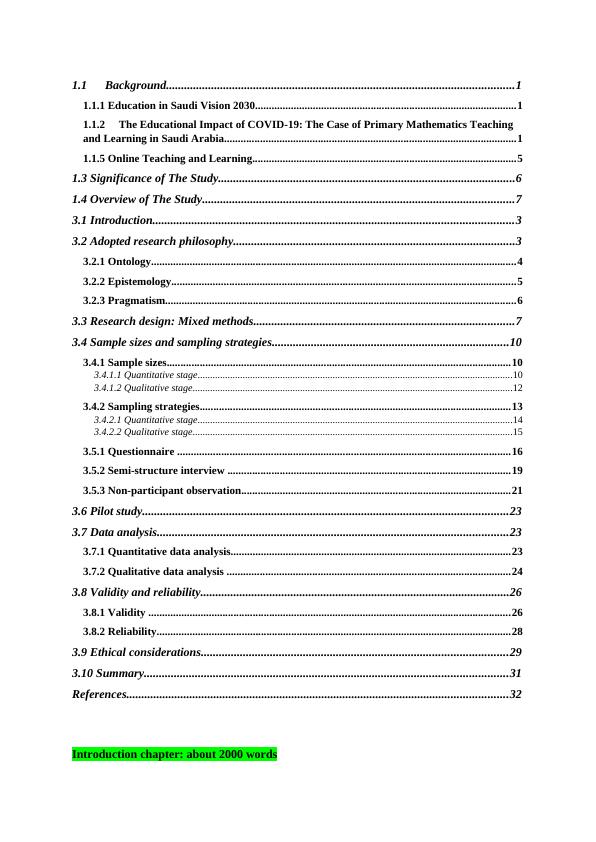
Literature review chapter: 3000 – 5000 words
Methodology chapter: 8000- 10000 words
Introduction Chapter
Methodology chapter: 8000- 10000 words
Introduction Chapter
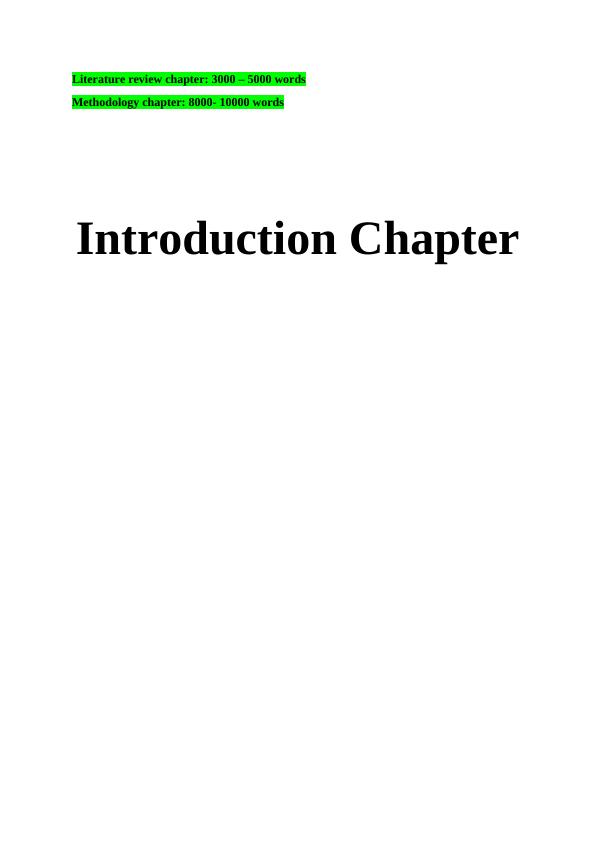
CHAPTER 1: INTRODUCTION
1.1 Background
1.1.1 Education in Saudi Vision 2030
The "Saudi Arabia Vision 2030" aims to develop education in several aspects (Saudi Vision,
2030, 2016). One of the main objectives of this national transformation program is to improve the
educational system in the country, such as improving the basis of learning, updating assessments and
curricula, and ensuring that education is not affected by any emergency, such as what happened with
COVID-19 (OCED, 2020). Although education was greatly affected by the global pandemic, the
speed of response by the Ministry of Education and the support of Vision(Education in Saudi Vision,
2030) alleviated the suffering of students and parents by providing an educational platform that
contributed to this crisis significantly (Saudi Ministry of Education, 2021). According to the Ministry
of Education of Saudi Arabia (2017), one of the goals of the Vision is to build the current curriculum
around the stringent requirements of character development, skills, numeracy, and literacy. To ensure
that educational achievements align with market demands, educational institutions need to work
closely with the corporate sector.Saudi Arabia has achieved universal access to education for a large
and geographically dispersed school-age population. With its impressive gains in enrolment, however,
Saudi Arabia has stretched the capacity of educators and administrators to deliver and assure high-
quality learning. The advances in participation will now need to be matched with equivalent progress
in student learning and skills if the Kingdom is to achieve the ambitious development goals outlined
in Vision 2030.
1.1.2 The Educational Impact of COVID-19: The Case of Primary Mathematics Teaching and
Learning in Saudi Arabia
1
1.1 Background
1.1.1 Education in Saudi Vision 2030
The "Saudi Arabia Vision 2030" aims to develop education in several aspects (Saudi Vision,
2030, 2016). One of the main objectives of this national transformation program is to improve the
educational system in the country, such as improving the basis of learning, updating assessments and
curricula, and ensuring that education is not affected by any emergency, such as what happened with
COVID-19 (OCED, 2020). Although education was greatly affected by the global pandemic, the
speed of response by the Ministry of Education and the support of Vision(Education in Saudi Vision,
2030) alleviated the suffering of students and parents by providing an educational platform that
contributed to this crisis significantly (Saudi Ministry of Education, 2021). According to the Ministry
of Education of Saudi Arabia (2017), one of the goals of the Vision is to build the current curriculum
around the stringent requirements of character development, skills, numeracy, and literacy. To ensure
that educational achievements align with market demands, educational institutions need to work
closely with the corporate sector.Saudi Arabia has achieved universal access to education for a large
and geographically dispersed school-age population. With its impressive gains in enrolment, however,
Saudi Arabia has stretched the capacity of educators and administrators to deliver and assure high-
quality learning. The advances in participation will now need to be matched with equivalent progress
in student learning and skills if the Kingdom is to achieve the ambitious development goals outlined
in Vision 2030.
1.1.2 The Educational Impact of COVID-19: The Case of Primary Mathematics Teaching and
Learning in Saudi Arabia
1
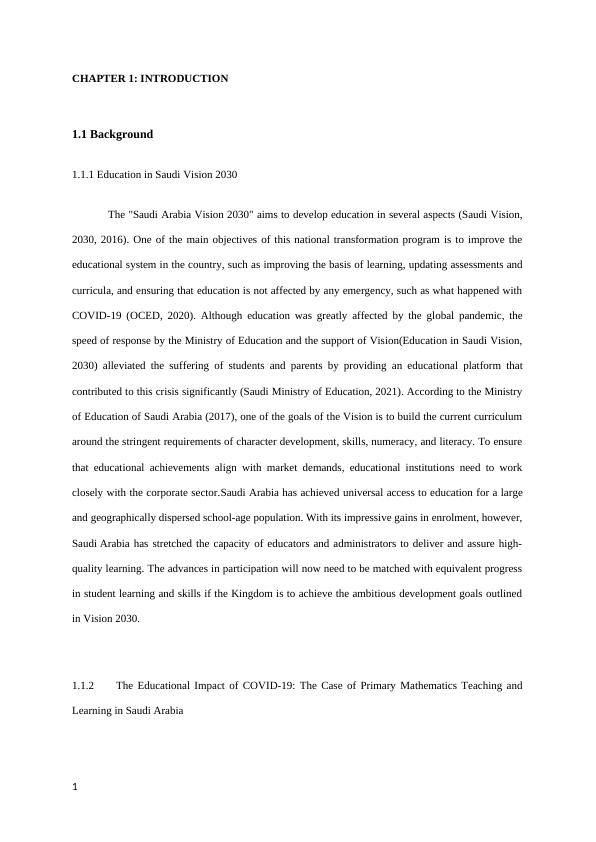
The effect of COVID-19 on the educational sector resulted in the closure of schools
worldwide (Oraif&Elyas, 2021). According to Rahman et al. (2019), more than one billion students in
schools and universities were affected by school closures. Moreover, the structure of learning and
schooling has been changed by the closing of schools. (Tarkar, 2020). Hence, education has changed
significantly with an increasing shift in technology usage and online teaching and learning methods
(Oraif&Elyas, 2021).
In Saudi Arabia, although online learning was implemented in the country before the
pandemic, it was simple and in its infancy. The educational system had to be changed significantly to
allow students to learn and attend schools remotely (Oraif&Elyas, 2021). For example, before the start
of the 2020 academic year, Saudi Arabia's Ministry of Education launched a new digital platform
called Madrasati (translated as "My School"). This new platform was built to tackle the impact of the
pandemic on education for both staff and students in the country (Alshehri et al., 2020). The digital
platform enables students and teachers to engage in visual communication, conduct classes online,
and conduct assessments and examinations. Alongside this digital platform, the Ministry also
introduced more than twenty TV channels for each educational level, ranging from primary to high
schools (Oraif&Elyas, 2021).
1.1.4 Saudi Arabia's Primary Mathematics Curriculum and Achievement
Saudi Vision 2030 emphasizes mathematics in elementary schools, where students' identities
are formed, and their minds are exposed to a wealth of previously unknown material. This paves the
way for knowledge and community engagement. This is due to the government's emphasis on
strengthening Science, Technology, Engineering, and Mathematics (STEM) education and putting
these topics at the forefront of educational advancement (Alhareth& Al Dighrir, 2014). According to
(Alhareth& Al Dighrir ,2014), the Saudi primary mathematics curriculum is built on real-life
applications that integrate science and mathematics. This might help students do better in math classes
2
worldwide (Oraif&Elyas, 2021). According to Rahman et al. (2019), more than one billion students in
schools and universities were affected by school closures. Moreover, the structure of learning and
schooling has been changed by the closing of schools. (Tarkar, 2020). Hence, education has changed
significantly with an increasing shift in technology usage and online teaching and learning methods
(Oraif&Elyas, 2021).
In Saudi Arabia, although online learning was implemented in the country before the
pandemic, it was simple and in its infancy. The educational system had to be changed significantly to
allow students to learn and attend schools remotely (Oraif&Elyas, 2021). For example, before the start
of the 2020 academic year, Saudi Arabia's Ministry of Education launched a new digital platform
called Madrasati (translated as "My School"). This new platform was built to tackle the impact of the
pandemic on education for both staff and students in the country (Alshehri et al., 2020). The digital
platform enables students and teachers to engage in visual communication, conduct classes online,
and conduct assessments and examinations. Alongside this digital platform, the Ministry also
introduced more than twenty TV channels for each educational level, ranging from primary to high
schools (Oraif&Elyas, 2021).
1.1.4 Saudi Arabia's Primary Mathematics Curriculum and Achievement
Saudi Vision 2030 emphasizes mathematics in elementary schools, where students' identities
are formed, and their minds are exposed to a wealth of previously unknown material. This paves the
way for knowledge and community engagement. This is due to the government's emphasis on
strengthening Science, Technology, Engineering, and Mathematics (STEM) education and putting
these topics at the forefront of educational advancement (Alhareth& Al Dighrir, 2014). According to
(Alhareth& Al Dighrir ,2014), the Saudi primary mathematics curriculum is built on real-life
applications that integrate science and mathematics. This might help students do better in math classes
2

and give them a better connection and knowledge of the curriculum's basic concepts (Alghamdi,
2017).
These best curricula are designed to promote balanced understanding and vertical integration
across disciplines at all levels of education (Alafaleq& Fan, 2014). This promotes the development of
higher cognitive and comprehensive mathematics abilities at all levels of education (Alshehri& Ali,
2016). The design of these mathematical subjects in schools is based on a variety of learning
objectives, including 1) examining concepts and developing cognitive skills, 2) developing
comprehensive mathematical skills and techniques, and 3) enabling students to use logical reasoning
to overcome challenges and difficulties in life (Alshehri& Ali, 2016).
According to Alabdulaziz and Higgins (2021), the elementary mathematics curriculum
includes the six main themes shown in table 1.1. It should be taught to students with practical
application in daily life. Regarding Saudi Arabian students' mathematical performance, the country's
position in the Trends in International Mathematics and Science Study (TIMSS) in 2019 might be
used. The framework for the 2019 TIMSS evaluation offers the foundation for four international tests,
including math and science, for fourth and eighth-grade pupils (Mullis & Martin, 2017). According to
the Education and Training Evaluation Commission (ETEC) in Saudi Arabia (2019), based on the
TIMSS report (2019) about the mathematics assessment, Saudi Arabia placed 53rd out of 58
participating nations (with a score of 398 out of 1000) for fourth graders. In comparison to their
counterparts in other countries, a substantial proportion of fourth-grade Saudi Arabian pupils lacked
the fundamental foundations of mathematics (ETEC, 2019).
Table 1.1
Domain Content
Number Whole numbers and comparisons of whole numbers
Place value up to1million
Fractions
Equivalent fractions (comparing, ordering, and placing them on a
number line)
3
2017).
These best curricula are designed to promote balanced understanding and vertical integration
across disciplines at all levels of education (Alafaleq& Fan, 2014). This promotes the development of
higher cognitive and comprehensive mathematics abilities at all levels of education (Alshehri& Ali,
2016). The design of these mathematical subjects in schools is based on a variety of learning
objectives, including 1) examining concepts and developing cognitive skills, 2) developing
comprehensive mathematical skills and techniques, and 3) enabling students to use logical reasoning
to overcome challenges and difficulties in life (Alshehri& Ali, 2016).
According to Alabdulaziz and Higgins (2021), the elementary mathematics curriculum
includes the six main themes shown in table 1.1. It should be taught to students with practical
application in daily life. Regarding Saudi Arabian students' mathematical performance, the country's
position in the Trends in International Mathematics and Science Study (TIMSS) in 2019 might be
used. The framework for the 2019 TIMSS evaluation offers the foundation for four international tests,
including math and science, for fourth and eighth-grade pupils (Mullis & Martin, 2017). According to
the Education and Training Evaluation Commission (ETEC) in Saudi Arabia (2019), based on the
TIMSS report (2019) about the mathematics assessment, Saudi Arabia placed 53rd out of 58
participating nations (with a score of 398 out of 1000) for fourth graders. In comparison to their
counterparts in other countries, a substantial proportion of fourth-grade Saudi Arabian pupils lacked
the fundamental foundations of mathematics (ETEC, 2019).
Table 1.1
Domain Content
Number Whole numbers and comparisons of whole numbers
Place value up to1million
Fractions
Equivalent fractions (comparing, ordering, and placing them on a
number line)
3
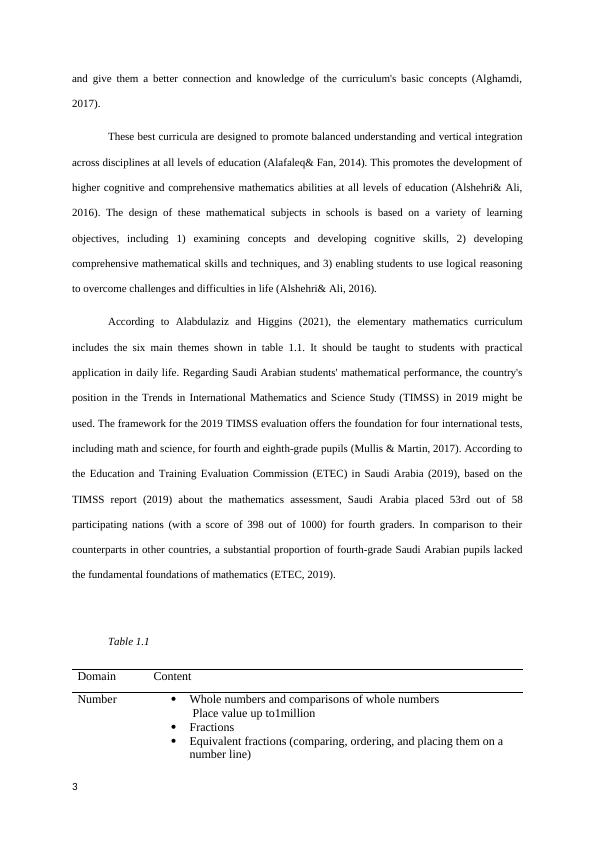
Categorizing fractions (rational, irrational, and decimal)
Algebra Defining and explaining patterns of multiplication and division
Properties of addition and multiplication
Basics of subtraction and division
Algebraic representations of number sentences
Measurement Units of length, area, volume, and mass
Time intervals.
Perimeter and area of squares
Geometry Categorizing and describing solids
Geometric concepts of lines (e.g., parallelism and perpendicularity)
Angles and types of angles polygons (e.g., triangles and congruence)
Locating numbers and fractions on a number line and a coordinate
plane
Statistics and
Probabilities
Data collection, organization, and representation (points, columns).
Creating bar graphs
Reading and explaining data.
Finding median and mode
Histograms, pie charts
Measures of central tendency
Range
Data analysis—interpretation and presentation § Measures of
dispersion
1.1.5 Online Teaching and Learning
With the focus of Saudi Vision 2030 on teaching and learning mathematics in primary schools, the
urgent need for online education has emerged dramatically after the global pandemic (Dhawan, 2020).
There was no agreement among scholars on a specific name for this type of education, as some used
to call it "open education." Fee (2009) referred to e-learning, while Salmon (2013) referred to it as
online education. Online education is defined as a way of transferring knowledge between the teacher
or the source and the learner through the Internet and using various devices, such as computers
(Dhawan, 2020; Nguyen, 2015).
4
Algebra Defining and explaining patterns of multiplication and division
Properties of addition and multiplication
Basics of subtraction and division
Algebraic representations of number sentences
Measurement Units of length, area, volume, and mass
Time intervals.
Perimeter and area of squares
Geometry Categorizing and describing solids
Geometric concepts of lines (e.g., parallelism and perpendicularity)
Angles and types of angles polygons (e.g., triangles and congruence)
Locating numbers and fractions on a number line and a coordinate
plane
Statistics and
Probabilities
Data collection, organization, and representation (points, columns).
Creating bar graphs
Reading and explaining data.
Finding median and mode
Histograms, pie charts
Measures of central tendency
Range
Data analysis—interpretation and presentation § Measures of
dispersion
1.1.5 Online Teaching and Learning
With the focus of Saudi Vision 2030 on teaching and learning mathematics in primary schools, the
urgent need for online education has emerged dramatically after the global pandemic (Dhawan, 2020).
There was no agreement among scholars on a specific name for this type of education, as some used
to call it "open education." Fee (2009) referred to e-learning, while Salmon (2013) referred to it as
online education. Online education is defined as a way of transferring knowledge between the teacher
or the source and the learner through the Internet and using various devices, such as computers
(Dhawan, 2020; Nguyen, 2015).
4
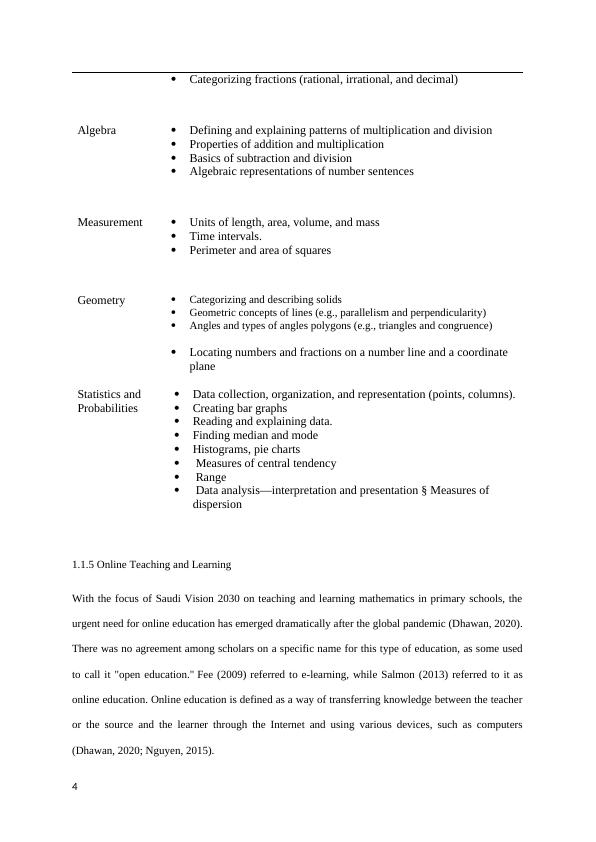
Online education is divided into two types, namely, synchronous and non-
synchronous education. Synchronous education refers to teaching and learning techniques in
which the learner(s) and instructor(s) are in the exact location at the same time to facilitate
learning (Oztok et al., 2013). Non-synchronous education's core idea is that learning may
occur multiple times and places depending on the learner (Yamagata-Lynch, 2014). When
there is a time constraint or a desire for flexibility in learning, this method is used (Yamagata-
Lynch, 2014). Learners have the option of downloading or attending their online session
whenever they wish. This form of learning allows for social interaction using a message
board, which is an example of an asynchronous tool, and the learner can learn mathematics at
their leisure. (Yamagata-Lynch, 2014).
1.2 Aims of The Study
The purpose of this study is to query the perceptions of Saudi primary school teachers and
students about online mathematics teaching and learning during the global pandemic. The goal of this
study is to find out what teachers and students in primary schools in the Kingdom of Saudi Arabia
have to deal with when they use online tools to teach and learn math.In addition, to see if there is an
effect of gender and years of teaching experience on using online tools in elementary school
mathematics teaching, It focuses on analysing the impact of teacher characteristics such as gender and
years of teaching experience. Albalaw (2017) It is believed that male teachers are more comfortable
with computer-enabled online media sources because it has been determined that male teachers with
at least ten years of teaching experience in the education environment in Saudi Arabia are more
comfortable using online educational tools and platforms than females in general (Bluegrass, 2017).
Furthermore, Wiseman et al. This results in educational benefits for teachers in a gender-segregated
society (Weizmann et al., 2018). Furthermore, Prendergast et al. (2018) argued that with the support
of the theory of planned behavior, parameters such as attitude and behaviour to adopt an entity, social
5
synchronous education. Synchronous education refers to teaching and learning techniques in
which the learner(s) and instructor(s) are in the exact location at the same time to facilitate
learning (Oztok et al., 2013). Non-synchronous education's core idea is that learning may
occur multiple times and places depending on the learner (Yamagata-Lynch, 2014). When
there is a time constraint or a desire for flexibility in learning, this method is used (Yamagata-
Lynch, 2014). Learners have the option of downloading or attending their online session
whenever they wish. This form of learning allows for social interaction using a message
board, which is an example of an asynchronous tool, and the learner can learn mathematics at
their leisure. (Yamagata-Lynch, 2014).
1.2 Aims of The Study
The purpose of this study is to query the perceptions of Saudi primary school teachers and
students about online mathematics teaching and learning during the global pandemic. The goal of this
study is to find out what teachers and students in primary schools in the Kingdom of Saudi Arabia
have to deal with when they use online tools to teach and learn math.In addition, to see if there is an
effect of gender and years of teaching experience on using online tools in elementary school
mathematics teaching, It focuses on analysing the impact of teacher characteristics such as gender and
years of teaching experience. Albalaw (2017) It is believed that male teachers are more comfortable
with computer-enabled online media sources because it has been determined that male teachers with
at least ten years of teaching experience in the education environment in Saudi Arabia are more
comfortable using online educational tools and platforms than females in general (Bluegrass, 2017).
Furthermore, Wiseman et al. This results in educational benefits for teachers in a gender-segregated
society (Weizmann et al., 2018). Furthermore, Prendergast et al. (2018) argued that with the support
of the theory of planned behavior, parameters such as attitude and behaviour to adopt an entity, social
5
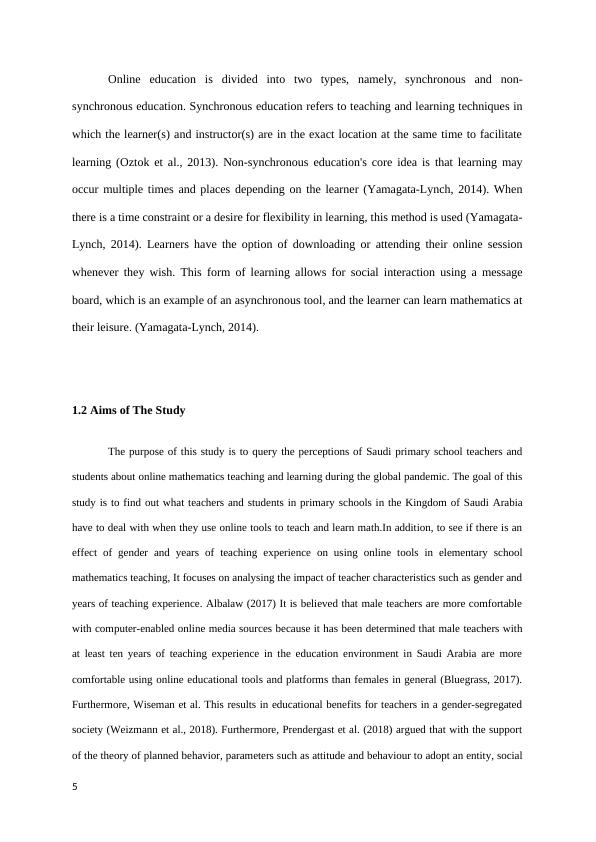
factors, and behavioural control of processes influence a specific segment of users in support of a
particular educational reform (Prendergast et al., 2018). The purpose of this question is to find out if
there is an effect of gender and years of teaching experience on the use of online tools in elementary
school mathematics teaching.
1.3 Significance of The Study
The results of this research will enable policymakers in Saudi Arabia, and more specifically, the Saudi
Minister of Education, to revise their policies on primary mathematics curriculum design to enhance
students' mathematics learning and knowledge. Since the spread of the COVID-19 pandemic, it has
led to the emergence of significant challenges in the education sector, and according to the Saudi
Minister of Education (2021),
And he added:
He is proud of the development of the education system in the Kingdom of Saudi
Arabia under the supervision of the Ministry of Education, expecting that distance
education will be a project for the future and will continue to benefit from it and
invest in it in all circumstances during the pandemic and after the pandemic, and this
is a quantum leap for the digitization of education at the level of the Kingdom
(Ministry of Education, 2021, para 8).
Hence, this study is vital and timely because it will provide a comprehensive understanding
of online learning tools and teaching, particularly about vital curricular subjects such as
mathematics.
Furthermore, this research aims to contribute to the field of educational research that focuses
on online learning and teaching. Using a mixed-method approach and collecting quantitative and
qualitative data via questionnaires, interviews, and observations leads to a more in-depth
understanding of the results as well as an increase in the validity of the study's results by using two or
more approaches to ensure their accuracy and reliability about the study under investigation. Finally,
6
particular educational reform (Prendergast et al., 2018). The purpose of this question is to find out if
there is an effect of gender and years of teaching experience on the use of online tools in elementary
school mathematics teaching.
1.3 Significance of The Study
The results of this research will enable policymakers in Saudi Arabia, and more specifically, the Saudi
Minister of Education, to revise their policies on primary mathematics curriculum design to enhance
students' mathematics learning and knowledge. Since the spread of the COVID-19 pandemic, it has
led to the emergence of significant challenges in the education sector, and according to the Saudi
Minister of Education (2021),
And he added:
He is proud of the development of the education system in the Kingdom of Saudi
Arabia under the supervision of the Ministry of Education, expecting that distance
education will be a project for the future and will continue to benefit from it and
invest in it in all circumstances during the pandemic and after the pandemic, and this
is a quantum leap for the digitization of education at the level of the Kingdom
(Ministry of Education, 2021, para 8).
Hence, this study is vital and timely because it will provide a comprehensive understanding
of online learning tools and teaching, particularly about vital curricular subjects such as
mathematics.
Furthermore, this research aims to contribute to the field of educational research that focuses
on online learning and teaching. Using a mixed-method approach and collecting quantitative and
qualitative data via questionnaires, interviews, and observations leads to a more in-depth
understanding of the results as well as an increase in the validity of the study's results by using two or
more approaches to ensure their accuracy and reliability about the study under investigation. Finally,
6

End of preview
Want to access all the pages? Upload your documents or become a member.
